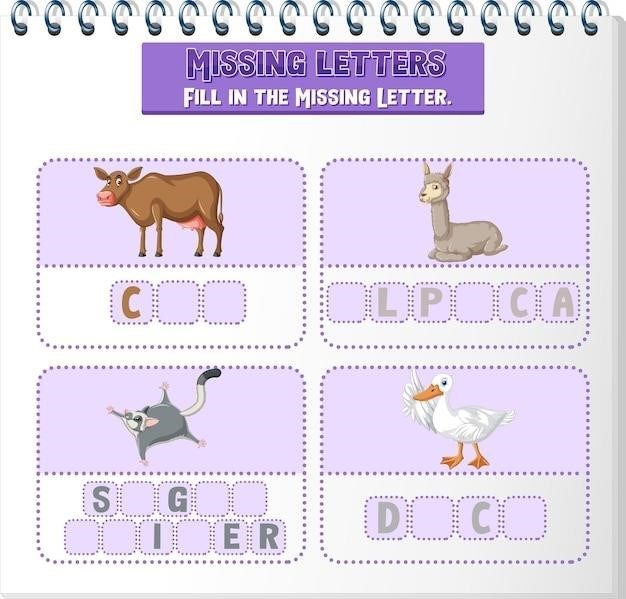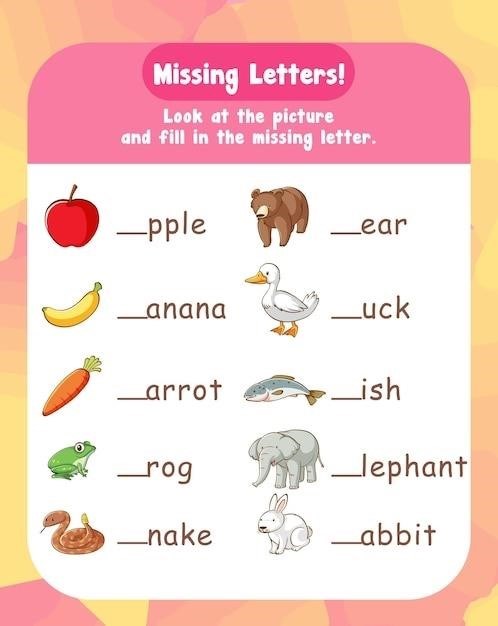A Comprehensive Guide to Vowel Worksheets (PDF)
This guide explores the world of vowel worksheets, offering various types focusing on short, long, and r-controlled vowels, digraphs, and diphthongs. Free downloadable PDFs cater to different grade levels (K-5), supporting both classroom and homeschooling needs. Discover effective usage tips and unlock the benefits of these essential learning tools.
Types of Vowel Worksheets Available
A wide array of vowel worksheets caters to diverse learning needs and stages. Basic worksheets focus on identifying the five primary vowels (a, e, i, o, u) within words, often employing simple illustrations to aid recognition. More advanced worksheets introduce short and long vowel sounds, requiring students to differentiate between their pronunciations and spellings. R-controlled vowel worksheets delve into the unique vowel sounds influenced by the letter ‘r’ (e.g., car, her, sir). Further specialization includes worksheets dedicated to vowel digraphs (two letters producing one vowel sound, such as ‘oa’ in ‘boat’) and diphthongs (two vowel sounds blending together, like ‘oi’ in ‘oil’). These progressive worksheet types build a strong foundation in phonics, enhancing reading and spelling abilities. Additionally, worksheets incorporating interactive elements, such as coloring or matching activities, can boost engagement and comprehension for young learners.
Short Vowel Worksheets⁚ Activities and Resources
Short vowel worksheets provide foundational phonics practice, focusing on the short sounds of a, e, i, o, and u. Activities often involve identifying words with specific short vowel sounds, circling the correct vowel in a word, or matching pictures to words containing the target sound. Many worksheets utilize CVC (consonant-vowel-consonant) words like “cat,” “bed,” “pig,” “dog,” and “sun” to simplify the learning process. Resources abound online, offering printable PDF worksheets with varying levels of difficulty. Some incorporate interactive elements like coloring or tracing, enhancing engagement. These worksheets are crucial for early readers, building a strong understanding of vowel sounds and their corresponding letter representations. The repetitive nature of these exercises solidifies phonetic awareness, paving the way for more complex reading and spelling skills. Many free resources are available, making them accessible for both classroom and home use.
Long Vowel Worksheets⁚ Engaging Exercises and Materials
Long vowel worksheets build upon the foundation of short vowel sounds, introducing the longer, more drawn-out pronunciations of a, e, i, o, and u. These worksheets often incorporate activities like matching long vowel sounds to their corresponding letters, reading simple one-syllable words containing long vowels, and distinguishing long vowel sounds within single-syllable words. Engaging exercises might involve creating sentences using words with long vowels or identifying the long vowel sound in a given word. Materials commonly include printable PDFs with various word lists, picture-matching activities, and fill-in-the-blank exercises. Some worksheets focus on specific vowel sounds, while others offer a mixed practice incorporating all five long vowels. The use of colorful visuals and engaging themes like animals or objects can enhance the learning experience, making it more appealing to young learners. These resources are invaluable in helping students master the complexities of long vowel sounds and develop their reading fluency.
Vowel Sounds Worksheets⁚ Focusing on Phonetics
These worksheets delve into the phonetic aspects of vowel sounds, moving beyond simple letter recognition to explore the nuances of pronunciation. Activities might involve identifying the vowel sound in a word and matching it to its phonetic symbol, or transcribing words based on their phonetic representation. Worksheets may include exercises focusing on specific vowel sounds, such as the short and long sounds of each vowel, or the various sounds produced by vowels in different phonetic contexts. The aim is to develop a strong understanding of the relationship between the written form of a vowel and its actual pronunciation. Students might be asked to identify words with the same vowel sound, regardless of the spelling, or to sort words based on their vowel sounds. The incorporation of audio resources can further enhance understanding, allowing students to hear the correct pronunciation of each vowel sound and practice their own pronunciation. Such worksheets are particularly useful for students struggling with phonics and pronunciation.
R-Controlled Vowel Worksheets⁚ Specific Sound Practice
R-controlled vowels represent a unique phonetic challenge, as the “r” sound modifies the vowel sound preceding it, creating distinct sounds not found in other vowel combinations. These worksheets offer focused practice on these complex vowel sounds, often denoted as “r-colored vowels.” Activities might involve identifying words with specific r-controlled vowel sounds, such as the “ar” sound in “car,” the “er” sound in “her,” or the “or” sound in “for.” Students may be asked to sort words based on their r-controlled vowel sounds, or to fill in missing letters in words containing these sounds. The worksheets can also include exercises that focus on the differences between r-controlled vowels and other similar-sounding vowels, helping students to distinguish between sounds like “ar” and “air,” or “or” and “ore.” Visual aids, such as pictures or diagrams illustrating mouth positions for r-controlled vowel sounds, can be very helpful for young learners. The goal is to build fluency and accuracy in recognizing and producing these often-confusing vowel sounds, improving reading and spelling skills.

Vowel Digraph and Diphthong Worksheets⁚ Advanced Vowel Combinations
These worksheets delve into the complexities of vowel digraphs and diphthongs, crucial for advanced phonics skills. Vowel digraphs, like “oa” in “boat” or “ee” in “sheep,” involve two vowels that combine to create a single vowel sound. Diphthongs, such as “oi” in “oil” or “ou” in “house,” involve a gliding sound where the tongue moves between two vowel positions within a single syllable. Worksheets might feature activities like identifying words containing specific digraphs or diphthongs, sorting words based on these combinations, or filling in missing letters to complete words. Students might also be asked to distinguish between similar-sounding digraphs or diphthongs, such as “ai” and “ay,” or “ow” and “ou,” strengthening their ability to decode and encode these more challenging vowel combinations. The inclusion of contextualized sentences or short reading passages can reinforce understanding, helping students to recognize these sounds within the flow of language. Visual aids, like sound charts or diagrams, can aid in comprehension, especially for younger learners or those requiring extra support. Mastering these combinations significantly improves reading fluency and spelling accuracy.
Vowel Worksheets for Different Grade Levels (K-5)
Vowel worksheets are meticulously designed to align with the developmental stages of children from kindergarten through fifth grade. Kindergarten worksheets typically focus on recognizing and identifying individual vowels (a, e, i, o, u), often employing colorful pictures and simple matching exercises. First and second grade progress to short and long vowel sounds, introducing CVC (consonant-vowel-consonant) words and simple word families. Third and fourth grade delve into more complex vowel combinations, including digraphs and diphthongs (like “oa,” “ee,” “oi,” “ou”), often incorporating reading passages and sentence completion activities. Fifth grade worksheets challenge students with more advanced vowel patterns, including r-controlled vowels and silent e rules, integrating advanced vocabulary and grammar concepts. The complexity of exercises gradually increases, mirroring the growing phonological awareness and reading comprehension skills of the students. The use of engaging visuals, interactive games, and varied activity types keeps learning stimulating and effective across all grade levels. This structured approach ensures a smooth transition and consistent progress in mastering vowel sounds and their various combinations.

Using Vowel Worksheets in Homeschooling
Vowel worksheets offer homeschooling parents a structured and effective tool for teaching phonics. The readily available, printable PDF format makes them incredibly convenient, eliminating the need for expensive workbooks or extensive lesson preparation. Parents can easily incorporate these worksheets into their daily curriculum, tailoring the activities to their child’s pace and learning style. The clear instructions and engaging exercises make the learning process enjoyable, fostering a positive attitude towards phonics. Furthermore, the variety of worksheets available – encompassing short vowels, long vowels, digraphs, and diphthongs – ensures comprehensive coverage of all vowel sounds. Regular use of these worksheets can significantly improve a child’s reading and spelling skills, building a strong foundation for future literacy development. Parents can track their child’s progress, identifying areas requiring extra attention and adapting their teaching strategies accordingly. This flexibility and personalized learning experience make vowel worksheets invaluable in the homeschooling environment, providing a supportive and efficient way to master phonics.
Benefits of Using Printable Vowel Worksheets (PDF)
Printable vowel worksheets offer numerous advantages for both educators and learners. Their immediate availability in PDF format eliminates the need for extensive preparation or costly resource purchases. This convenience is particularly beneficial for teachers with large class sizes or homeschooling parents managing multiple children. The versatility of printable worksheets allows for customized learning experiences. Teachers can select specific worksheets targeting individual student needs, focusing on areas requiring reinforcement. The interactive nature of many vowel worksheets actively engages students, making learning fun and effective. Worksheets often include a variety of exercises like tracing, coloring, matching, and writing, catering to different learning styles. Regular use of these worksheets helps students develop a strong understanding of vowel sounds and their spellings, improving reading comprehension and spelling skills. The immediate feedback provided by many worksheet activities allows for prompt identification of areas needing further practice. The printable nature also ensures accessibility, eliminating concerns about internet access or technical difficulties. Moreover, completed worksheets provide a tangible record of student progress, facilitating monitoring and evaluation.
Free Vowel Worksheets⁚ Downloadable Resources
The internet offers a wealth of free, downloadable vowel worksheets in PDF format, catering to various age groups and skill levels. Many educational websites and online resources provide these valuable tools, making them easily accessible to teachers, parents, and homeschoolers. These free resources often feature diverse activities, including tracing exercises, matching games, fill-in-the-blank sentences, and word searches, making learning engaging and interactive. The variety in worksheet designs ensures that students remain interested and motivated throughout the learning process. These free worksheets frequently cover various vowel types, from short and long vowels to vowel digraphs and diphthongs, providing comprehensive phonics practice. Furthermore, many websites offer worksheets categorized by grade level, allowing for targeted learning based on a child’s current skillset. This targeted approach ensures that the exercises remain challenging yet attainable, promoting a positive learning experience. The availability of free downloadable resources removes financial barriers, making quality educational materials accessible to all. Remember to always check the license terms before using any downloaded materials.
Tips for Effective Use of Vowel Worksheets
Maximize the impact of vowel worksheets by incorporating them strategically into your teaching plan. Begin by assessing the student’s current understanding of vowel sounds to select appropriate worksheets. Introduce new concepts gradually, focusing on one vowel sound at a time before moving to more complex combinations. Make the learning process interactive and engaging by incorporating games and activities. Encourage students to read aloud the words and sentences on the worksheets to reinforce pronunciation and comprehension. Provide positive reinforcement and encouragement to build confidence and motivation. Incorporate real-world examples to connect the concepts to everyday language. Regularly review previously learned material to ensure retention. Don’t hesitate to adapt or modify the worksheets to meet the individual needs of your students. Consider using different colored pencils or markers to highlight vowel sounds within words. For younger learners, use visual aids like pictures or objects to represent the words. Finally, remember that consistent practice is key to mastering vowel sounds. Regular use of these worksheets, coupled with other phonics activities, will significantly improve a student’s reading and spelling skills.